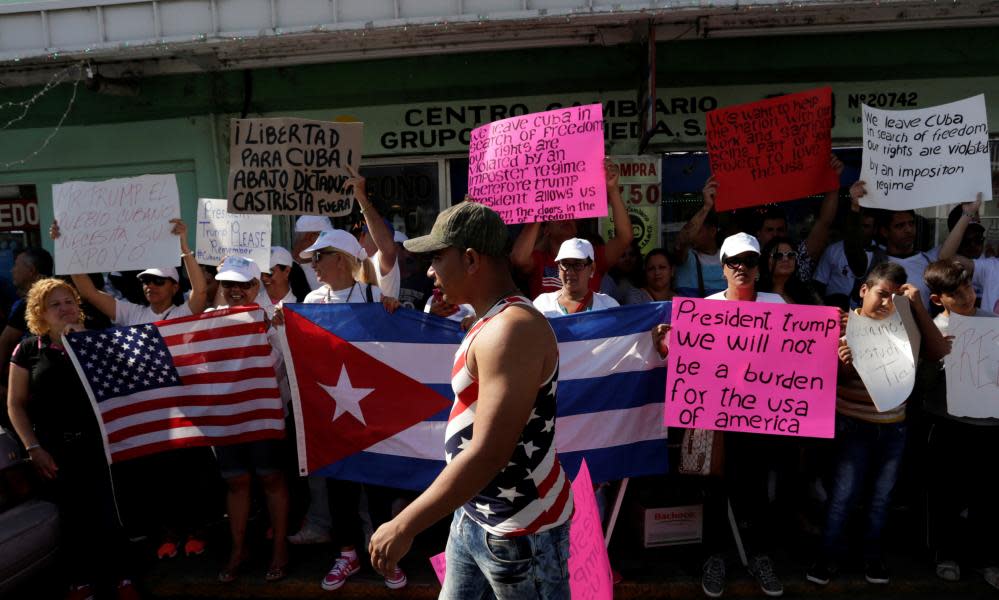More Cubans seek asylum in Mexico amid clampdown on legal path to US

Yatsel Jerez Ramón has been in Mexico for six weeks, and so far, nothing has gone well for the Cuban migrant trying to reach the United States.
On his first night in Tenosique, a small city in the southern border state of Tabasco, Jerez, 37, narrowly escaped a police raid at his hotel. The following day, a man posing as a state lawyer convinced him to hand over $500 to obtain a humanitarian visa with which, Jerez was told, he’d be able to safely continue his passage north.
Related: Migrants brave the 'Beast' as Mexico cracks down under US pressure
Jerez was travelling with several other Cubans, and together they also forked out $2,000 for an amparo – a legal petition used to temporarily suspend deportation if detained by immigration agents.
“We arrived blind,” Jerez told the Guardian, “trusted in what people said, but everyone took advantage of us.”
Armed with the visa and amparo, Jerez boarded a bus heading north hoping to reach the US border within the week, but didn’t get far.
Jerez was detained at the first checkpoint leaving Tenosique after immigration agents who boarded the bus said the visa was fraudulent, and taken to the overcrowded National Migration Institute (INM) detention centre.
Here, according to Jerez, he was threatened with prosecution – and eight years in jail – for false documents if he dared apply for asylum, rather than agreeing to deportation. The amparo was proclaimed useless.
For Jerez, going back to Havana wasn’t an option: “I just want to continue on my journey to the US. But I’m scared of being deported, so even if it takes months, seeking asylum in Mexico seems like my only option to reach the border.”
Jerez is among a rapidly growing number of Cubans turning to the Mexican asylum system amid a clampdown on alternative legal routes.
In the first seven months of this year, 4,604 Cubans applied for asylum in Mexico, representing 10% of all applicants. In 2018, 218 Cubans sought asylum, representing 1% of total applicants.
Historically, US-bound Cubans encountered far fewer obstacles on the migration passage due to unique legal protections and economic and educational advantages compared with Central Americans.
But, a crackdown by the US and Mexican governments has left tens of thousands of Cubans trapped in Mexico, facing the same dangers and hurdles as migrants from elsewhere. In April, Cubans spearheaded a mass escape from one overflowing detention centre in protest at delays and inhumane conditions.
The Cubans’ plights can be traced back to Barack Obama’s second term, when reducing migration was a key issue in bilateral discussions that eventually led to the historic diplomatic thaw between the old foes.
Mexico was instrumental in implementing this deal to curtail Cuban migration, according to Rodolfo Casillas, a migration scholar at the Latin American Faculty of Social Sciences (Flacso): Mexico detained 14,000 Cubans during 2015 and 2016 as rumours about a change in US policy prompted a surge in Cubans leaving the island.
Related: 'They threw us into the street': Cubans tell of struggles to enter US
In 2017, just days before leaving the White House, Obama revoked the “wet foot, dry foot” policy which treated all Cubans arriving on US soil as political refugees, authorized to stay and legalize their status. Since then, Cubans have been obliged to enter the backlogged and time-consuming US asylum process like everyone else.
Now, the impact of Donald Trump’s policy is hitting Cubans in Mexico: in the north, thousands are waiting in line in border cities like Ciudad Juárez to present their asylum cases at ports of entry.
En route, 5,512 Cubans were detained in the first six months of this year, compared with 504 during the whole of 2018. (710 have been deported this year, compared with 156 in 2018.)
In the south, in cities like Tenosique and Tapachula, those without the means to pay people smugglers are trapped since the exit pass – which allowed select nationals including Cubans and Haitians to traverse Mexico legally – was revoked in early 2019 amid the threat of crippling trade tariffs by Trump.
“The tap has been turned off,” said Ramón Márquez, director of the La72 migrant shelter, where 228 Cubans sought refugee in the first seven months of 2019, compared with 23 in 2019.
“Mexico’s only policy objective is to avoid conflict with Trump,” said Casillas from Flacso. “This means stopping the flow of migrants, whatever it takes, which is fuelling people smuggling and asylum cases.”
In Tenosique, most Cubans can be found renting cramped, very basic digs, looking for a safe route out of the boiling hot city where violent crimes against migrants have long been tolerated by authorities.
Yilesy González, 40, from the city of Cárdenas, sold the family home and left Cuba with her husband in mid-July, leaving behind their two children with her mother. González says that life had become intolerable since 2017, when authorities discovered the makeshift boat they’d built to sail across the Caribbean Sea to Honduras.
The couple share an airless rented room with six others on the outskirts of the city, who are all waiting for appointments with the Mexican refugee agency. They don’t have family in the US to help pay for a coyote (guide). “We’d be happy to stay in Mexico, but not here, somewhere with jobs, so we could make a life.”
Josep Herreros, a UN refugee agency protection officer in Mexico, said: “The dramatic increase in Cubans seeking asylum reflects changes in migration policies in Mexico, rather than changes in their home country.
“There must be safe legal paths to migration, so that asylum is only used by those who need international protection.”

